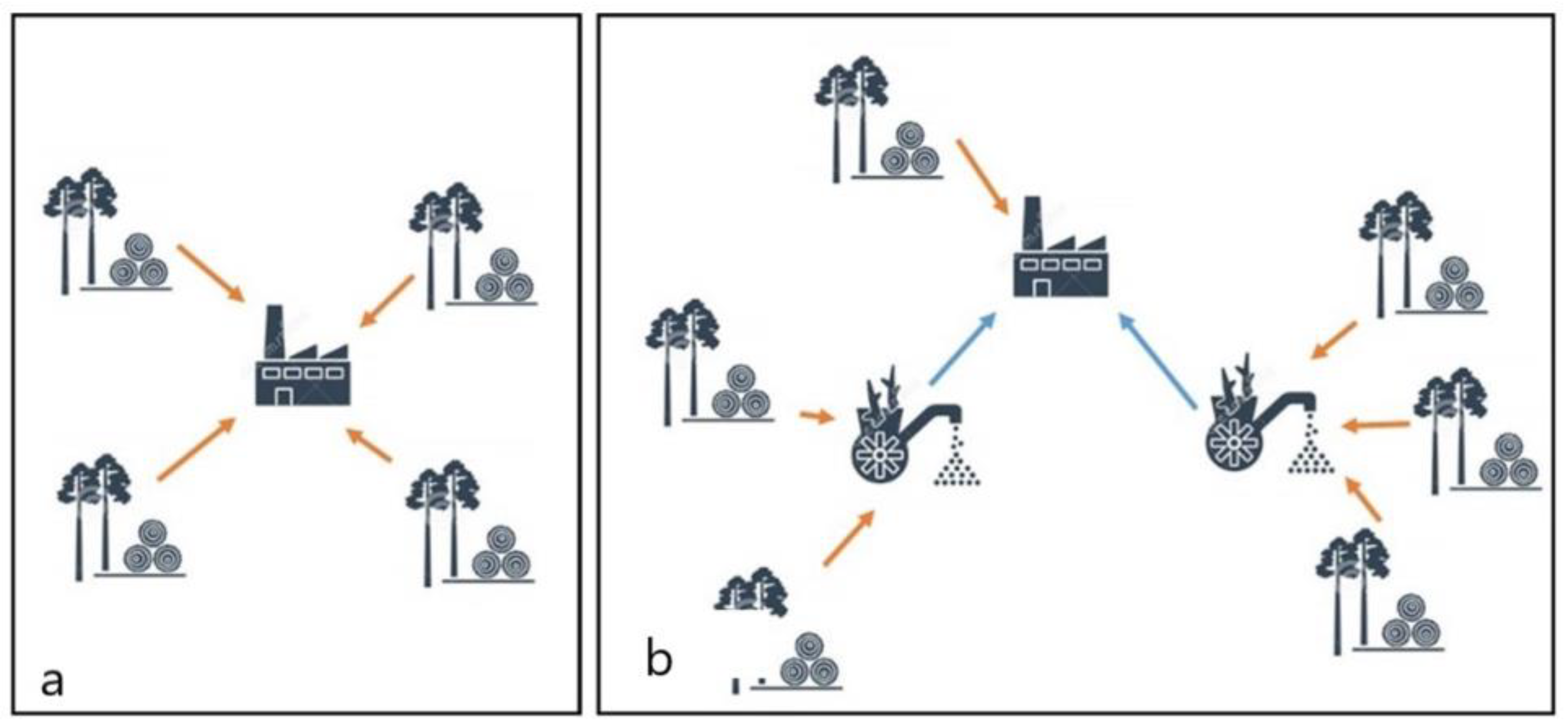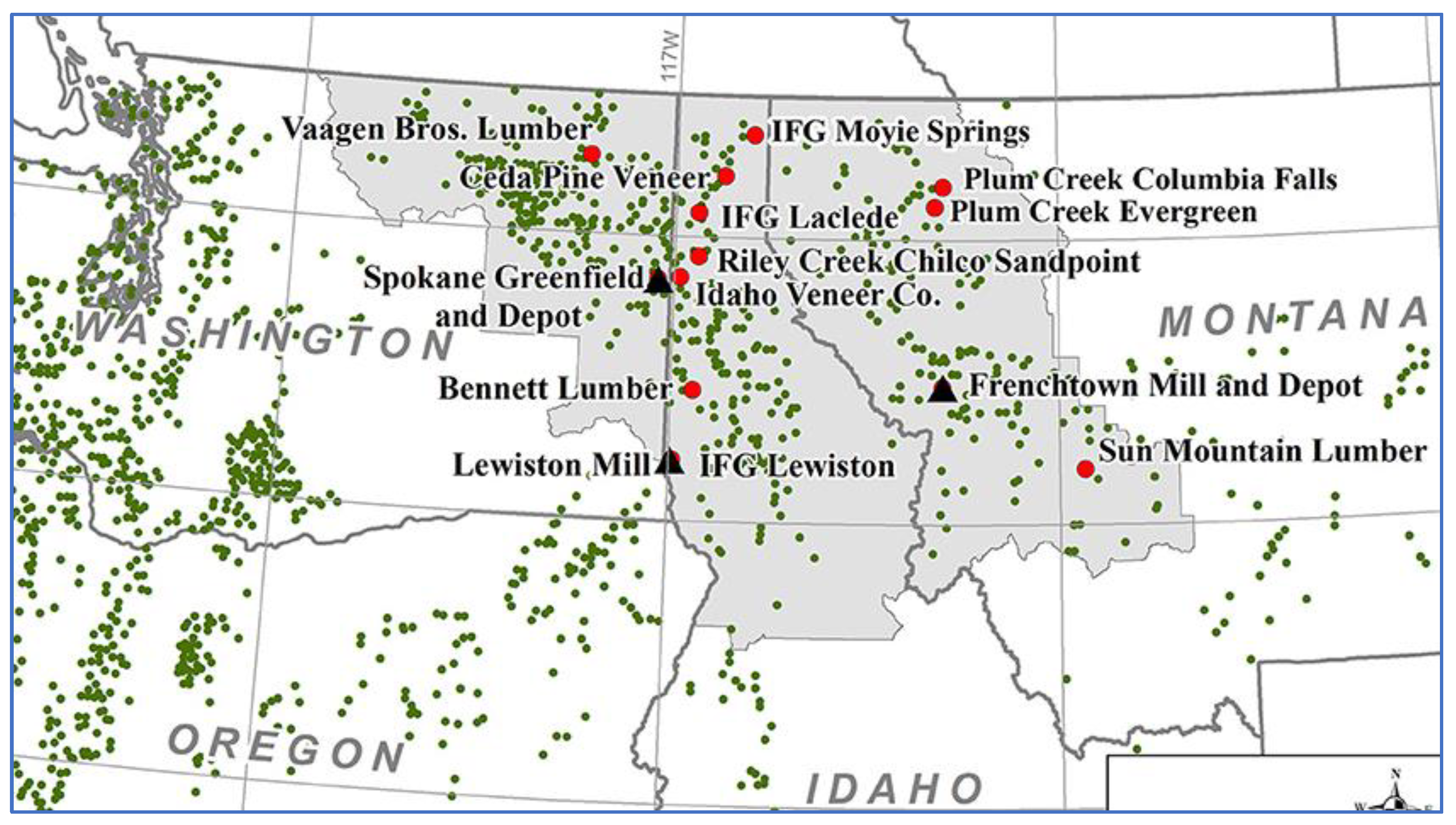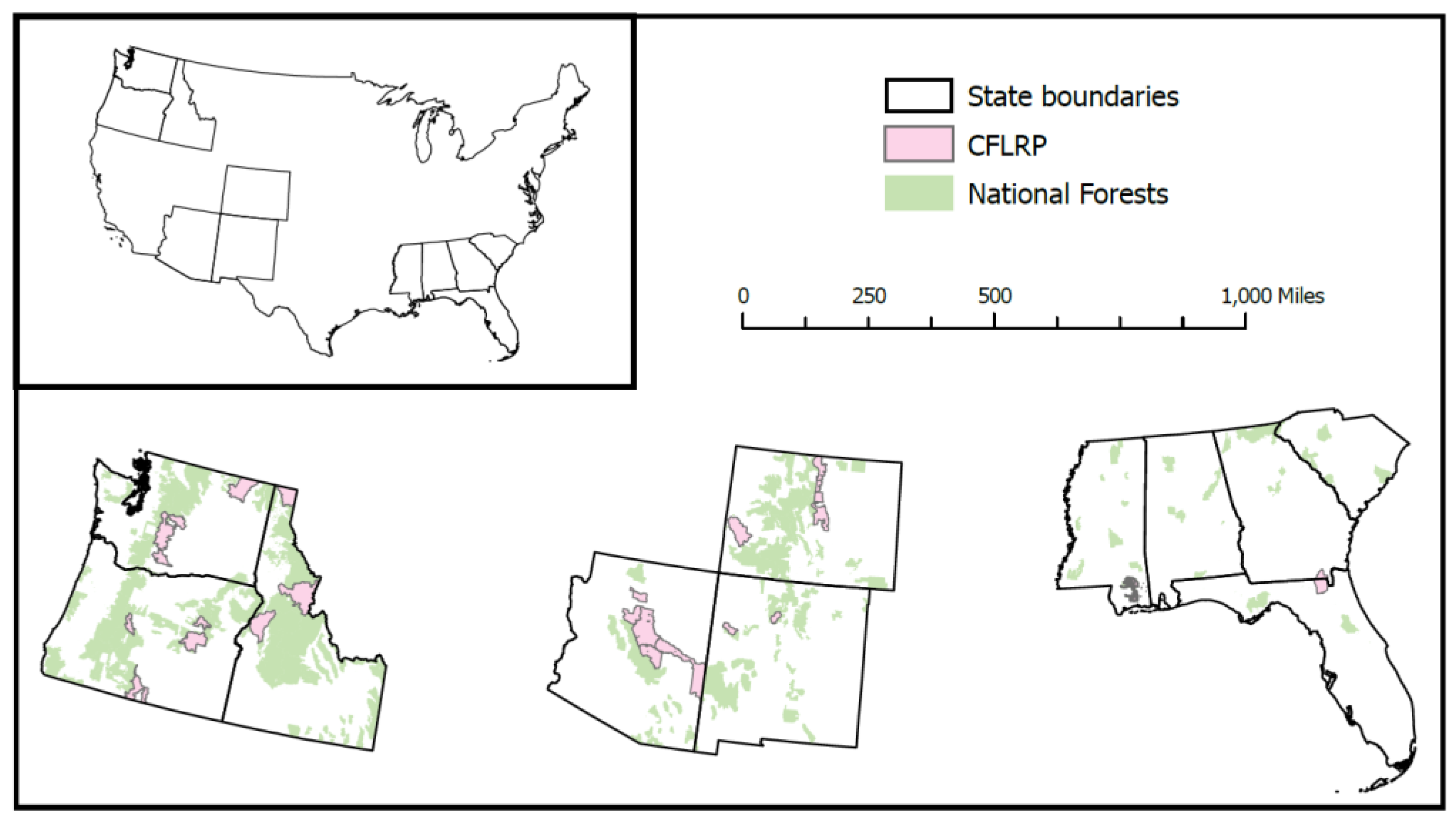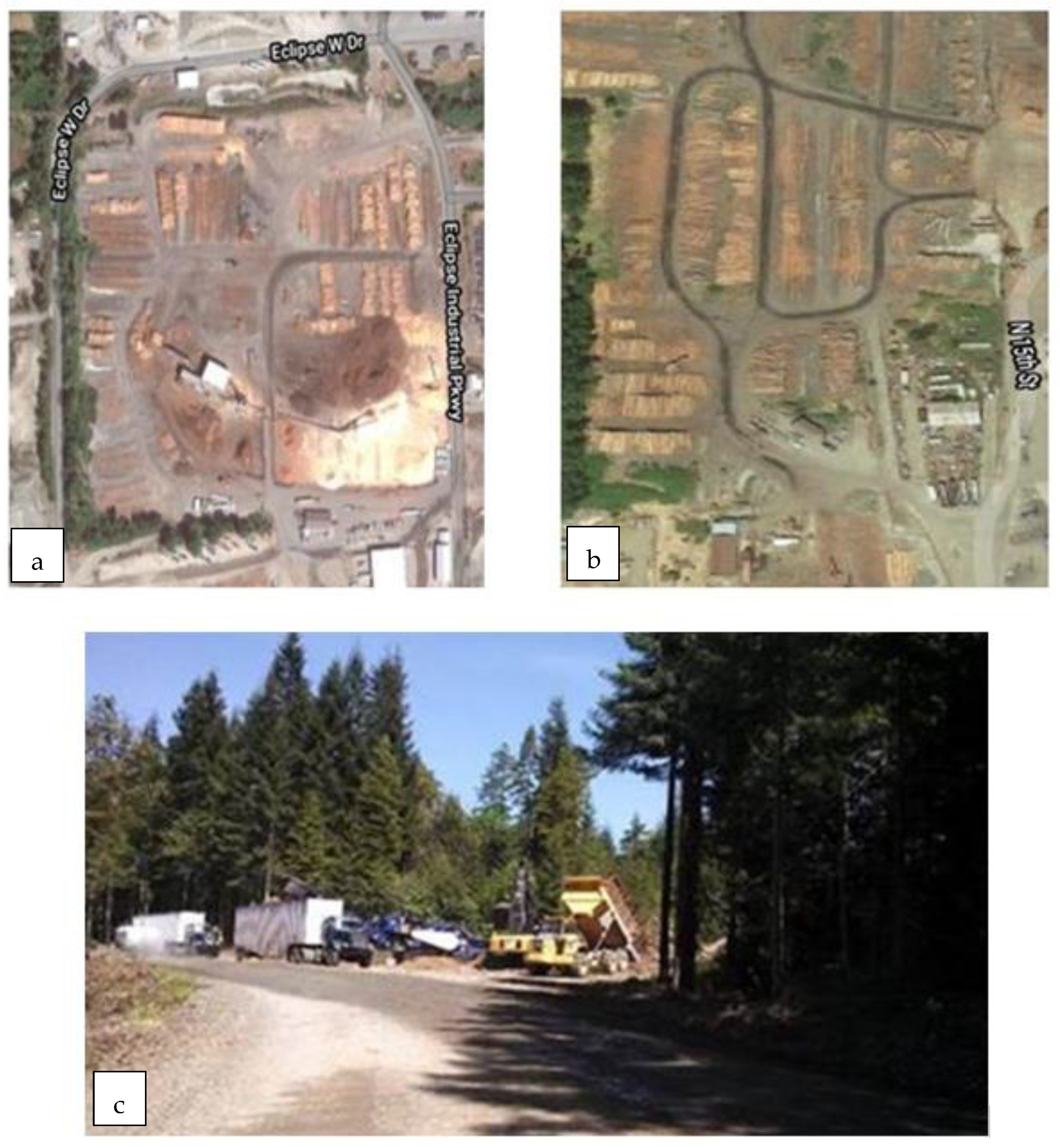Forest Bio-Hubs to Enhance Forest Health While Supporting the Emerging Bioeconomy—A Comparison between Three U.S. Regions
Abstract
:1. Introduction
1.1. Forest Bio-Hubs: Context and Definition
1.2. Overview of Bio-Hub Research
1.3. Forest Bio-Hubs in U.S. Forests
1.4. Scope and Objectives
- To provide regional summaries of three U.S. regions regarding what bio-hub configurations are closest to being commercialized, and
- To conduct a “SWOT” assessment of the three regions regarding forest bio-hub potential
2. Summary of Forest Bio-Hub Potential in Three Regions
2.1. Pacific Northwest Region
2.2. Southwest Region
2.3. Southeast Region
3. Strengths, Weaknesses, Opportunities and Threats Analysis
4. Discussion
4.1. Bio-Hub Configurations Must Be Tailored to the Unique Characteristics of a Region
4.2. The Emerging Bio-Economy and Replacement of Fossil Fuels
4.3. Forest Bio-Hubs to Support Forest Health and Reduce Fire Risk
- Sustainable forest management does not lead to deforestation since net harvests and net growth should be in balance
- In many forest ecosystems, including those addressed in this paper, forests that are left alone (i.e., unmanaged) are likely to experience drought, fire, or insect infestations, in part brought upon by climate change
- Forests managed for climate adaptation and mitigation often result in the generation biomass materials having little or no economic value. Forest biohubs are one avenue for marketing these otherwise unmerchantable materials, and this is especially the case for privately owned forests.
5. Conclusions
Author Contributions
Funding
Informed Consent Statement
Acknowledgments
Conflicts of Interest
References
- US EPA. Final Renewable Fuel Standards for 2020, and the Biomass-Based Diesel Volume for 2021. Available online: https://www.epa.gov/renewable-fuel-standard-program/final-renewable-fuel-standards-2020-and-biomass-based-diesel-volume#rule-summary (accessed on 29 October 2021).
- Nicholls, D.L.; Halbrook, J.M.; Benedum, M.E.; Han, H.S.; Lowell, E.C.; Becker, D.R.; Barbour, R.J. Socioeconomic constraints to biomass removal from forest lands for fire risk reduction in the Western U.S. Forests 2018, 9, 264. [Google Scholar] [CrossRef] [Green Version]
- Lamers, P.; Tan, E.C.D.; Searcy, E.M.; Scarlata, C.J.; Cafferty, K.G.; Jacobson, J.J. Strategic Supply System Design—A Holistic Evaluation of Operational and Production Cost for a Biorefinery Supply Chain. Biofuel. Bioprod. Biorefin. 2015, 9, 648–660. [Google Scholar] [CrossRef]
- Argo, A.; Tan, E.; Inman, D.; Langholtz, M.; Eaton, L.; Jacobson, J.; Wright, C.; Muth, D.J.; Wu, M.M.; Chiu, Y.; et al. Investigation of biochemical biorefinery sizing and environmental sustainability impacts for conventional bale system and advanced uniform biomass logistics designs. Biofuel. Bioprod. Biorefin. 2013, 7, 282–302. [Google Scholar] [CrossRef] [Green Version]
- Lamers, P.; Roni, M.S.; Tumuluru, J.S.; Jacobson, J.J.; Cafferty, K.G.; Hansen, J.K.; Kenney, K.; Teymouri, F.; Bals, B. Techno-economic analysis of decentralized biomass processing depots. Bioresour. Technol. 2015, 194, 205–213. [Google Scholar] [CrossRef] [Green Version]
- Muth, D.J.; Langholtz, M.H.; Tan, E.C.D.; Jacobson, J.J.; Schwab, A.; Wu, M.M.; Argo, A.; Brandt, C.C.; Cafferty, K.G.; Chiu, Y.-W.; et al. Investigation of thermochemical biorefinery sizing and environmental sustainability impacts for conventional supply system and distributed pre-processing supply system designs. Biofuel. Bioprod. Biorefin. 2014, 8, 545–567. [Google Scholar] [CrossRef]
- Martinkus, N.; Latta, G.; Brandt, K.; Wolcott, M. A multi-criteria decision analysis approach to facility siting in a wood-based depot-and-biorefinery supply chain model. Front. Energy Res. 2018, 6, 124. [Google Scholar] [CrossRef]
- International Energy Agency. 2020. Task 43- Biomass Supply. Available online: https://task43.ieabioenergy.com/ (accessed on 29 October 2021).
- Bals, B.D.; Dale, B.E. Developing a Model for Assessing Biomass Processing Technologies within a Local Biomass Processing Depot. Bioresour. Technol. 2012, 106, 161–169. [Google Scholar] [CrossRef]
- Sterbova, M.; Loucanova, E.; Palus, H.; Ivan, L.; Salka, J. Innovation Strategy in Slovak Forest Contractor Firms—A SWOT Analysis. Forests 2016, 7, 118. [Google Scholar] [CrossRef] [Green Version]
- Eranki, P.L.; Manowitz, D.H.; Bals, B.D.; Izaurralde, C.; Kim, S.; Dale, B.E. The watershed-scale optimized and rearranged landscape design (WORLD) model and local biomass processing depots for sustainable biofuel production: Integrated life cycle assessments. Biofuel. Bioprod. Biorefin. 2013, 7, 537–550. [Google Scholar] [CrossRef]
- Kline, K.L.; Dale, V.H.; Rose, E.; Tonn, B. Effects of Production of Woody Pellets in the Southeastern United States on the Sustainable Development Goals. Sustainability 2021, 13, 821. [Google Scholar] [CrossRef]
- Halbrook, J.; Han, H.-S. Chip & Ship: Testing the Logistics of Supplying Wood Chips over Long Distance Using Intermodal Railroad Transportation; Northern Arizona University Ecological Restoration Institute: Flagstaff, AZ, USA, 2019; 28p. [Google Scholar]
- Brodbeck, A. Timber Industry Consolidation and the Need for Scale Appropriate Harvesting Mechanisms in Alabama’s Black Belt. Master’s Thesis, Auburn University, Auburn, AL, USA, 2005; 170p. [Google Scholar]
- USDA Forest Service. Collaborative Forest Landscape Restoration Program, Washington, DC, USA. 2019. Available online: https://www.fs.fed.us/restoration/CFLRP/ (accessed on 29 October 2021).
- Schultz, C.A.; Jedd, T.; Beam, R.D. The Collaborative Forest Landscape Restoration Program: A History and Overview of the First Projects. J. For. 2012, 110, 381–391. [Google Scholar] [CrossRef]
- Chan, C. Supporting Local Rural Economies while Improving Forest Health, Washington, DC, USA. 2017. Available online: https://www.usda.gov/media/blog/2015/06/22/supporting-local-rural-economies-while-improving-forest-health (accessed on 25 January 2022).
- Anderson, N.; Mitchell, D. Forest operations and woody biomass logistics to improve efficiency, value, and sustainability. Bioenergy Res. 2016, 9, 518–533. [Google Scholar] [CrossRef]
- Rummer, B.; Klepac, J.; Thompson, J. Technology for biomass feedstock production in southern forests and GHG implications. In Proceedings of the 16th Biennial Southern Silvicultural Research Conference; Butnor, J.R., Ed.; e-Gen. Tech. Rep. SRS-156; US Department of Agriculture Forest Service, Southern Research Station: Asheville, NC, USA, 2012; Volume 156, pp. 278–282. [Google Scholar]
- Iversen, K.; Van Demark, R. Integrating fuel reduction management with local bioenergy operations and businesses—A community responsibility. Biomass Bioenergy 2006, 30, 304–307. [Google Scholar] [CrossRef]
- City of Flagstaff, Arizona, Flagstaff Ranger District, Coconino National Forest. Flagstaff Watershed Protection Project Executive Summary & Implementation Plan. 2012; 16p. Available online: https://www.flagstaff.az.gov/DocumentCenter/View/41236/Ex-Summ-Impl-Plan_Dec12?bidId= (accessed on 29 October 2021).
- Huang, C.H.; Finkral, A.; Sorensen, C.; Kolb, T. Toward full economic valuation of forest fuels-reduction treatments. J. Environ. Manag. 2013, 130, 221–231. [Google Scholar] [CrossRef]
- Lynch, D.L. What do forest fires really cost? J. For. 2004, 102, 42–49. [Google Scholar]
- Nicholls, D. Forest Products Cluster Development in Central Arizona—Implications for Landscape-Scale Forest Restoration; Gen. Tech. Rep. PNW-GTR-898; U.S. Department of Agriculture, Forest Service, Pacific Northwest Research Station: Portland, OR, USA, 2014; 18p. [Google Scholar]
- Vaughan, D.R.; Edgeley, C.; Han, H.-S. Forest contracting businesses in the US Southwest: Current profile and workforce training needs. J. For. 2021, in press. [Google Scholar]
- Butler, B.J.; Wear, D.N. Forest ownership dynamics of southern forests. In The Southern Forest Futures Project: Technical Report; Wear, D.N., Greis, J.G., Eds.; Gen. Tech. Rep. SRS-GTR-178; USDA-Forest Service, Southern Research Station: Asheville, NC, USA, 2013; pp. 103–121. [Google Scholar]
- Conrad, J.L., IV; Greene, W.D.; Hiesl, P. A review of changes in US logging businesses 1980s–Present. J. For. 2018, 116, 291–303. [Google Scholar] [CrossRef]
- Steele, P.H.; Risbrudt, C.D. Efficiency of softwood sawmills in the southern United States in relation to capacity. Prod. J. 1985, 35, 51–56. [Google Scholar]
- Cesafsky, K.D.; (Chief Sustainability Officer, Enviva Corporation, Tokyo, Japan). Personal communication, 2019.
- Barrett, S.M.; Bolding, M.C.; Aust, W.M.; Munsell, J.F. Characteristics of logging businesses that harvest biomass for energy production. For. Prod. J. 2014, 64, 265–272. [Google Scholar] [CrossRef]
- Baker, S.A.; Westbrook, M.D., Jr.; Greene, W.D. Evaluation of integrated harvesting systems in pine stands of the southern United States. Biomass Bioenergy 2010, 34, 720–727. [Google Scholar] [CrossRef]
- Shresthra, S.P.; Lanford, B.L. Comparison of timber utilization between a tree-length and an in-wood chipping harvesting operations. In Forest Engineering Challenges: A Global Perspective, Proceedings of the 25th Annual Council on Forest Engineering Meeting, Auburn, AL, USA, 16–20 June 2002; Council on Forest Engineering: Corvallis, OR, USA, 2002; 5p. [Google Scholar]
- Cass, R.D.; Baker, S.A.; Greene, W.D. Cost and productivity impacts of product sorting on conventional ground-based timber harvesting operations. Prod. J. 2009, 59, 108–114. [Google Scholar] [CrossRef]
- Grushecky, S.T.; Wang, J.; Mcgill, D.W. Influence of site characteristics and costs of extraction and trucking on logging residue utilization in southern West Virginia. Prod. J. 2007, 57, 63–67. [Google Scholar]
- Conrad, J.L., IV; Bolding, M.C.; Smith, R.L.; Aust, W.M. Wood-energy market impact on competition, procurement practices, and profitability of landowners and forest products industry in the US south. Biomass Bioenergy 2011, 35, 280–287. [Google Scholar] [CrossRef]
- Ng, R.T.L.; Kurniawan, D.; Wang, H.; Mariska, B.; Wu, W.; Maravelias, C.T. Integrated framework for designing spatially explicit biofuel supply chains. Appl. Energy 2018, 216, 116–131. [Google Scholar] [CrossRef]
- Han, H.-S.; Bilek, E.M.; Dramm, J.; Loeffler, D.; Calkin, D. Financial Feasibility of a Log Sort Yard Handling Small-Diameter Logs: A Preliminary Study. West. J. Appl. For. 2011, 26, 174–182. [Google Scholar] [CrossRef] [Green Version]
- Berry, M.; Sessions, J. The Economics of Biomass Logistics and Conversion Facility Mobility: An Oregon Case Study. Appl. Eng. Agric. 2018, 34, 57–72. [Google Scholar] [CrossRef] [Green Version]
- Kumar, B.; Verma, P. Biomass-based biorefineries: An important architype towards a circular economy. Fuel 2021, 288, 119622. [Google Scholar] [CrossRef]
- Kohli, K.; Prajapati, R.; Sharma, B.K. Review Bio-Based Chemicals from Renewable Biomass for Integrated Biorefineries. Energies 2019, 12, 233. [Google Scholar] [CrossRef] [Green Version]
- Brandt, K.L.; Gao, J.; Wang, J.; Wooley, R.J.; Wolcott, M. Techno-Economic Analysis of Forest Residue Conversion to Sugar Using Three-Stage Milling as Pretreatment. Front. Energy Res. 2018, 6, 77. [Google Scholar] [CrossRef]
- Cambero, C.; Sowlati, T. Assessment and optimization of forest biomass supply chains from economic, social and environmental perspectives—A review of literature. Renew. Sustain. Energy Rev. 2014, 36, 62–73. [Google Scholar] [CrossRef]
- Mirkouei, A.; Haapala, K.R.; Sessions, J.; Murthy, G.S. A review and future directions in techno-economic modeling and optimization of upstream forest biomass to bio-oil supply chains. Renew. Sustain. Energy Rev. 2017, 67, 15–35. [Google Scholar] [CrossRef]
- Blackmer, E.D.; Christian, L.J.; Conway, R.T. Building a Stewardship Economy: Insights from Community Innovation in the Rural American West. Master’s Thesis., University of Michigan School for Environment and Sustainability, Ann Arbor, MI, USA, 2020; 186p. [Google Scholar]
- Madeira, L.; Gartner, T. Forest Resilience Bond Sparks Innovative Collaborations Between Water Utilities and Wide-Ranging Stakeholders. J. -Am. Water Work. Assoc. 2018, 110, 42–49. [Google Scholar] [CrossRef]




| Pacific Northwest (PNW) | Southwest (SW) | Southeast (SE) | |
|---|---|---|---|
| Strengths |
|
|
|
| Advantages of bio-hub compared with a traditional supply chain? | |||
| Weaknesses |
|
|
|
| Disadvantages of bio-hub compared with a traditional supply chain? | |||
| Opportunities |
|
|
|
| How to improve feasibility of developing bio-hub? | |||
| Threats |
|
|
|
| What may stand in the way of developing bio-hub? |
Publisher’s Note: MDPI stays neutral with regard to jurisdictional claims in published maps and institutional affiliations. |
© 2022 by the authors. Licensee MDPI, Basel, Switzerland. This article is an open access article distributed under the terms and conditions of the Creative Commons Attribution (CC BY) license (https://creativecommons.org/licenses/by/4.0/).
Share and Cite
Nicholls, D.; Vaughan, D.; Mitchell, D.; Han, H.-S.; Smidt, M.; Sessions, J. Forest Bio-Hubs to Enhance Forest Health While Supporting the Emerging Bioeconomy—A Comparison between Three U.S. Regions. Energies 2022, 15, 931. https://doi.org/10.3390/en15030931
Nicholls D, Vaughan D, Mitchell D, Han H-S, Smidt M, Sessions J. Forest Bio-Hubs to Enhance Forest Health While Supporting the Emerging Bioeconomy—A Comparison between Three U.S. Regions. Energies. 2022; 15(3):931. https://doi.org/10.3390/en15030931
Chicago/Turabian StyleNicholls, David, Damon Vaughan, Dana Mitchell, Han-Sup Han, Mathew Smidt, and John Sessions. 2022. "Forest Bio-Hubs to Enhance Forest Health While Supporting the Emerging Bioeconomy—A Comparison between Three U.S. Regions" Energies 15, no. 3: 931. https://doi.org/10.3390/en15030931
APA StyleNicholls, D., Vaughan, D., Mitchell, D., Han, H.-S., Smidt, M., & Sessions, J. (2022). Forest Bio-Hubs to Enhance Forest Health While Supporting the Emerging Bioeconomy—A Comparison between Three U.S. Regions. Energies, 15(3), 931. https://doi.org/10.3390/en15030931







